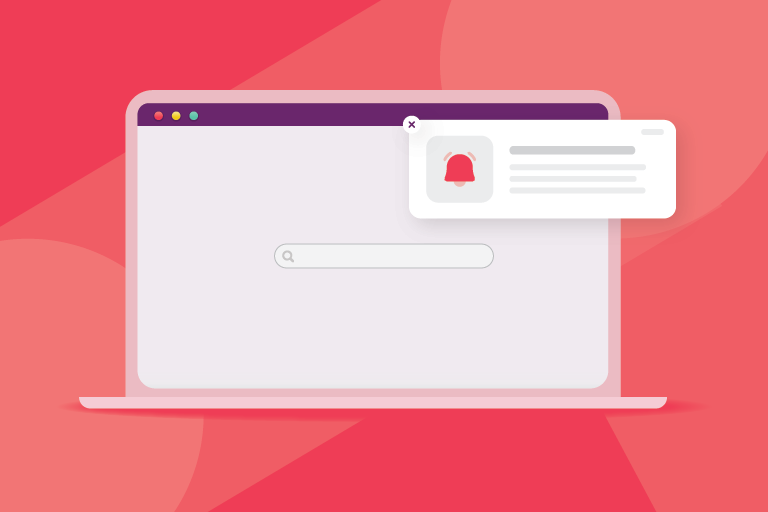Web push notifications are messages that you can send through a browser to a user’s device. That could include a smartphone, tablet, or desktop computer. The user doesn’t have to be on your website to get the message, they just need to have a browser such as Chrome or Firefox open.
The goal of web push notifications is to get people to re-engage with your website or brand. These notifications typically contain a brief text box with a link or photo and are meant to drive the recipient to take some action. That might include making another purchase or leaving a review for your product. For example, you might send a web push notification that alerts your customer to a 50% off deal to entice them to return to your site. These notifications are meant to have a sense of urgency.
How Do Web Push Notifications Work?
A user only has to visit your website once to be a potential candidate for web push notifications. You can use a
cross-channel marketing platform to initiate an opt-in to appear after a user has spent a little time browsing your site.
There are both soft and hard opt-in options. A
hard option simply asks the visitor to click yes or no on whether to receive notifications from your site. A
soft opt-in uses two dialogue boxes, with the first one explaining the benefits of your notifications.
With a soft opt-in, a site dedicated to cooking, for example, might alert people that agreeing to notifications means they’ll hear about new recipes first. Both opt-in types have their benefits and drawbacks. A hard opt-in is more streamlined, but a soft opt-in gives you a chance at asking a customer again if they say no the first time.
Once customers agree to receive notifications, they’ll receive them whenever they have a browser open. Web push looks different based on the type of browser, but they typically appear as small alerts in the top right or bottom right of the screen. On a mobile device, they look almost identical to the push notifications people receive from an app. When users click on the notification, it will then take them to your chosen destination.
The Benefits
One of the biggest upsides to web push is their reach. Once people opt in, you’re able to catch them whenever they have a browser open. Unlike app push notifications, the user doesn’t have to download your app first. In fact, web push notifications are a workaround if you don’t have an app.
Web push notifications are also more timely and reliable than email marketing efforts. They won’t end up in someone’s spam folder and they have a high open rate—
the open rate for web push notifications can be 15%, up to 18% for rich web push. Because users don’t have to provide personal information to receive web notifications, they’re also more likely to opt in to receive them. The opt-out rate for web push notifications is also low.
These notifications can drive conversions because they keep customers up-to-date on your sales, offers, and new products. They can also boost traffic to your website through the use of engaging headlines and links that point people toward your website or social media channels.
What are the Best Ways to Use Web Push Notifications?
There are dozens of ways you can use web push notifications to encourage
customer retention and engagement. These notifications allow you to reach your customers based on their past behaviors and on the devices and platforms of their choosing. There are some types of web push notifications that can be particularly successful, including:
- Promotional: These notifications can alert users to exclusive offers, new discounts, your latest ebook, or a new line of products.
- Personalized: Tailor messages to reach users at different points in the customer lifecycle. You can send a welcome message to a new customer encouraging them to follow you on social media, or special offers to a customer who hasn’t visited your site in a long time.
- Feedback requests: A perfect way to engage customers is to ask them to review your business, leave a rating, or offer constructive feedback.
- Helpful updates: Communicate with your customers regarding order status or to send alerts when items they’ve left abandoned in their shopping carts go on sale.
Be sure to keep your notifications clear, concise, and engaging. You have limited space to catch someone’s attention and get your message across.
The most successful web push notifications follow some basic guidelines: They are personalized based on a user’s location, language and behavior. And finally, they have a clear purpose through a call to action that very directly spells out the action users should be taking.
How to Use Web Push Notifications in Cross-Channel Marketing
Web push notifications are a powerful way to get a nearly instantaneous reaction from consumers. They can become even more beneficial when combined with other marketing channels for a seamless cross-channel marketing plan. Combining web push with
emails,
SMS, and
mobile push notifications, and
in-app messages ensures you’re tapping into a wide market of current and potential customers. In particular, web push notifications can be used very successfully to elevate the visibility of some of your longer-form content such as emails or blog posts, or to notify customers of limited-time sales and promotional offers.
Using a cross-channel marketing platform like Iterable, you can incorporate web push notifications into a cohesive cross-channel marketing plan that enables you to engage with customers across all of their preferred marketing channels, at the times when they’re most likely to interact. By developing personalized user experiences based on each customer’s unique preferences and behaviors, you can drive higher engagement levels and conversion rates.






























